 |
|
IN THIS ISSUE:
» Snapback TVSs Deliver More Accurate And Robust Circuit Protection
» Designing An Open-Source Power Inverter (Part 24): Inverter Output Filter Conundrum
» Current Mode-Controlled DC-DC Regulators (Part 3): CC-CV Regulation
» Focus On Magnetics:
How To Model Coupled Inductors In A SEPIC Converter
» New on How2Power.com
» Power Products
» Other Top Power News
From the Editor's Desk David G. Morrison
Editor, HOW2POWER TODAY

Some years ago we published a presentation by one of our contributors titled, “Surges and Transients Can’t Read Specifications! How to Protect Power Supplies Against Real-World Threats.” That humorous introduction to the subject of transient and surge immunity made the point that designers not only have to meet the relevant standards required for compliance, they often have to exceed those requirements in order to properly protect their electronic designs. Perhaps another takeaway from that document was that, within the reasonable limits of cost and other constraints, your circuit protection cannot be too robust because of the inherent unpredictability of electrical overstress events. The need for greater robustness is also driven by the increasing vulnerability of chips manufactured in advanced CMOS processes, and market pressures to make equipment more reliable. A feature in this issue by Kevin Parmenter looks at a newer class of overvoltage protection devices that offers more robust circuit protection by changing the way a TVS clamps a voltage transient. Kevin’s article on snapback TVSs explains how these devices provide more accurate protection as well as resilience in the face of repeated events. While such advances in circuit protection seem relatively infrequent, they are nonetheless vital to the success of many electronic designs and will always present opportunities for further improvement through the use of new materials, device design and packaging. This issue of How2Power Today also introduces articles discussing a unique dual-loop architecture that provides CC-CV regulation, output filter design for the open-source power inverter, and a guide to modeling coupled inductors in SEPIC converters. Enjoy these features along with the latest power product news and more in the February issue.
|
|

|
HOW2POWER EXCLUSIVE DESIGN ARTICLES 
|
Snapback TVSs Deliver More Accurate And Robust Circuit Protection
by Kevin Parmenter, Taiwan Semiconductor, Brea, Calif.
In the rapidly advancing world of electronics, circuit protection is critical to ensuring equipment and system longevity, reliability, and safety. One of the latest innovations in this field is snapback TVS (transient voltage suppressor) technology. While no device is perfect for all applications, the advancement of snapback TVS technology brings the industry closer to the ideal solution for protecting many applications across various markets, including consumer electronics where warranty returns can consume entire profit margins. This article discusses the technology and market trends that are driving adoption of TVSs, the pros and cons of conventional TVS devices, and how snapback TVS device technology offers a groundbreaking approach to circuit protection. Read the article…
|
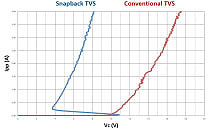
Unlike traditional TVS diodes which
simply clamp the voltage at a certain
threshold during a surge, a snapback
TVS reduces its clamping voltage once it
begins conducting. |

|
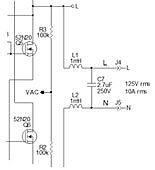
The motivation for this modified
version of the L-C filter (with
uncoupled inductors) is explained
in this part. |
Designing An Open-Source Power Inverter (Part 24): Inverter Output Filter Conundrum
by Dennis Feucht, Innovatia Laboratories, Cayo, Belize
As we approach the end of this Volksinverter design series, we address an aspect of power inverter performance that will be critical to commercial implementations of this design for compliance reasons as well as for the proper operation of the equipment being powered. The issue at hand is EMI, and specifically the conducted EMI produced by the inverter. The Volksinverter output stage—the inverter itself—has an LC filter. Will it adequately attenuate EMI currents? In this part we analyze operation of the LC filter, and discuss different possible solutions to suppression of common-mode currents, but ultimately settle on a modified configuration of the filter. We also analyze how PWM switching sequences affect EMI performance and which sequences are optimal. In the last section, filter design equations are presented. Read the article…
|

Current Mode-Controlled DC-DC Regulators (Part 3): CC-CV Regulation
by Timothy Hegarty, Texas Instruments, Phoenix, Ariz.
This article examines a constant-current, constant-voltage (CC-CV) dual-loop architecture for a dc-dc regulator that provides a constant output voltage or constant output current, depending on the application requirement and operating condition. The author outlines incumbent designs for the CC circuit that work as an add-on to a conventional dc-dc regulator. He then details a CC-CV integrated circuit (IC) approach with low external component count, reduced cost, accurate current-setpoint performance and improved transient response. The IC implementation is unique in that it selects the minimum of the currents from the transconductance error amplifiers in the CV and CC loops. This error current then flows in a shared compensation component network, the resultant compensation voltage becoming the reference command of the inner current loop of the current-mode architecture detailed in parts 1 and 2. Read the article…
|
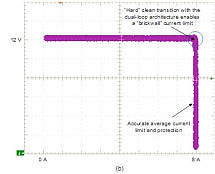
An integrated solution for a CC-CV
buck regulator based on an enhanced
dual-loop architecture minimizes
interaction of the CV and CC loops,
achieving a clean transition from CV
to CC and vice versa. |


FOCUS ON MAGNETICS 
Sponsored by Payton Planar Magnetics
A monthly column presenting information on power magnetics design, products, or related technology |
How To Model Coupled Inductors In A SEPIC Converter
by Wei Gu, Analog Devices, San Jose, Calif.
Converter designs based on the single-ended primary inductance converter (SEPIC) topology often opt to use a coupled inductor both to reduce the number of components and overall converter size, and to simplify control. However, this design choice complicates simulation: If the coupled inductor is not modeled correctly, the simulated result can be quite different from the bench result. Unfortunately, there is not much guidance on this topic in the literature, particularly with regard to the SEPIC. This article discusses how to best model coupled inductors in a SEPIC design. Methods to build a proper model are introduced and the equations are included.
Read the article…
|

 |
 |

 |

|

 |

|

NEW ON HOW2POWER.COM
 |
|
Calendar of Events — Over 200 Listings For 2025
HOW2POWER’s Events Calendar lists selected conferences, tradeshows, workshops and webinars related directly or indirectly to power electronics. Our calendar currently lists over 200 of the electronics industry’s top events for 2025.
Visit this section …
|


POWER PRODUCTS  |

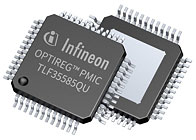
Infineon Technologies’
TLF35585 OPTIREG PMIC. |
PMIC Powers Automotive MCUs In Functional Safety Applications
 Photo: The IC provides an integrated multi-rail power supply solution for demanding automotive systems in segments such as chassis, safety, ADAS, powertrain, and drive train. Designed for safety-relevant applications, it includes a boost-buck pre-regulator supplying post regulator rails for microcontroller supply, communication supply and a precise voltage reference. In addition, two trackers following the voltage reference are available to supply off-board sensors. Photo: The IC provides an integrated multi-rail power supply solution for demanding automotive systems in segments such as chassis, safety, ADAS, powertrain, and drive train. Designed for safety-relevant applications, it includes a boost-buck pre-regulator supplying post regulator rails for microcontroller supply, communication supply and a precise voltage reference. In addition, two trackers following the voltage reference are available to supply off-board sensors.
See the full story…
|

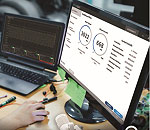
Power Integrations’ MotorXpert
v3.0 software suite. |
Software Drives FOC Motors Without Shunts Or Sensors, Has Improved GUI
 Photo: A software companion to BridgeSwitch motor-driver ICs that controls and configures high-efficiency single- and three-phase BLDC inverters, version 3.0 includes the company’s shuntless and sensorless technology for field-oriented control, adding support for advanced modulation schemes and unconditional startup under any load condition. Photo: A software companion to BridgeSwitch motor-driver ICs that controls and configures high-efficiency single- and three-phase BLDC inverters, version 3.0 includes the company’s shuntless and sensorless technology for field-oriented control, adding support for advanced modulation schemes and unconditional startup under any load condition.
See the full story…
|

 |

|

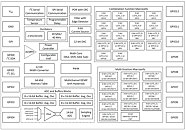
Renesas Electronics’ SLG47011,
SLG47004-A and SLG47001/3
AnalogPAK ICs. |
Programmable Mixed-Signal ICs Feature Low-Power Device With 14-Bit SAR ADC
 Diagram: These AnalogPAK members of the GreenPAK family feature the SLG47011, which contains a rich set of digital and analog features including a programable multichannel 14-bit SAR ADC. This chip also has user-defined power saving modes for all macrocells that enable designers to switch off some blocks in sleep mode and reduce consumption to the microamp level. Diagram: These AnalogPAK members of the GreenPAK family feature the SLG47011, which contains a rich set of digital and analog features including a programable multichannel 14-bit SAR ADC. This chip also has user-defined power saving modes for all macrocells that enable designers to switch off some blocks in sleep mode and reduce consumption to the microamp level.
See the full story…
|


Cambridge GaN Devices’ CGD-ASY-EVB030FA-01
TP-PFC eval board. |
Evaluation Board Offers High-Efficiency 3-kW Totem-Pole PFC
 Photo: The totem-pole PFC evaluation board is engineered to deliver exceptional efficiency, meeting 80+ Titanium standards when paired with a downstream dc-dc converter. Photo: The totem-pole PFC evaluation board is engineered to deliver exceptional efficiency, meeting 80+ Titanium standards when paired with a downstream dc-dc converter.
See the full story…
|

|







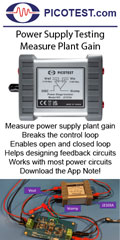
|

 |
 |

 |
 |

OTHER TOP POWER NEWS
|
|
 In its 2025 predictions – GaN power semiconductors, Infineon highlights the ways in which gallium nitride will be a game-changing semiconductor material. In its 2025 predictions – GaN power semiconductors, Infineon highlights the ways in which gallium nitride will be a game-changing semiconductor material.
 The EOS/ESD Association has released a new article to the ESDA website describing the importance, value and criticality of the ANSI/ESD S20.20 standard. The EOS/ESD Association has released a new article to the ESDA website describing the importance, value and criticality of the ANSI/ESD S20.20 standard.
 For those looking to present at ECCE 2025, March 2nd is the deadline for submissions of paper digests as well as proposals for special sessions and tutorials. For those looking to present at ECCE 2025, March 2nd is the deadline for submissions of paper digests as well as proposals for special sessions and tutorials.


|


 The APEC 2025 conference committee has announced the four distinguished plenary speakers for its 40th anniversary program. The APEC 2025 conference committee has announced the four distinguished plenary speakers for its 40th anniversary program.
 The 2025 CPES Annual Conference, which will be held April 14-16, will showcase key innovations from the labs sponsored by the CPES Industry Consortium. Complimentary registration is available to Consortium Members. The 2025 CPES Annual Conference, which will be held April 14-16, will showcase key innovations from the labs sponsored by the CPES Industry Consortium. Complimentary registration is available to Consortium Members.
 Registration is now open for the Fifth International Symposium on 3D Power Electronics Integration and Manufacturing (3D-PEIM). Registration is now open for the Fifth International Symposium on 3D Power Electronics Integration and Manufacturing (3D-PEIM).




 CPES has announced three professional short courses for 2025: “Power Electronics Packaging,” June 23-27; “Modeling & Control Design of DC-DC Converters,” July 28-August 1 and “EMI Analysis and Solutions for Power Electronics,” August 4-8. CPES has announced three professional short courses for 2025: “Power Electronics Packaging,” June 23-27; “Modeling & Control Design of DC-DC Converters,” July 28-August 1 and “EMI Analysis and Solutions for Power Electronics,” August 4-8.
 The agenda for the upcoming 2025 ARPA-E Summit is now available on the summit website. The agenda highlights disruptive technology demonstrations, networking opportunities, ARPA-E Fast Pitches, and Breakout panel sessions. The agenda for the upcoming 2025 ARPA-E Summit is now available on the summit website. The agenda highlights disruptive technology demonstrations, networking opportunities, ARPA-E Fast Pitches, and Breakout panel sessions.




 A team led by NoMIS Power is a Phase 1 winner of the U.S. DOE’s American-Made Silicon Carbide Packaging Prize. A team led by NoMIS Power is a Phase 1 winner of the U.S. DOE’s American-Made Silicon Carbide Packaging Prize.
 Strata Clean Energy has completed a 70-MW, 280-MWh energy storage project in Rialto, California. Strata Clean Energy has completed a 70-MW, 280-MWh energy storage project in Rialto, California.

ABOUT THIS NEWSLETTER: Thank you for reading HOW2POWER TODAY.
How2Power sends no more than one e-mail per month to registered users. Continuing your subscription ensures you'll receive future newsletters. Manage Your Subscription
©2020 All rights reserved. www.how2power.com
|
|